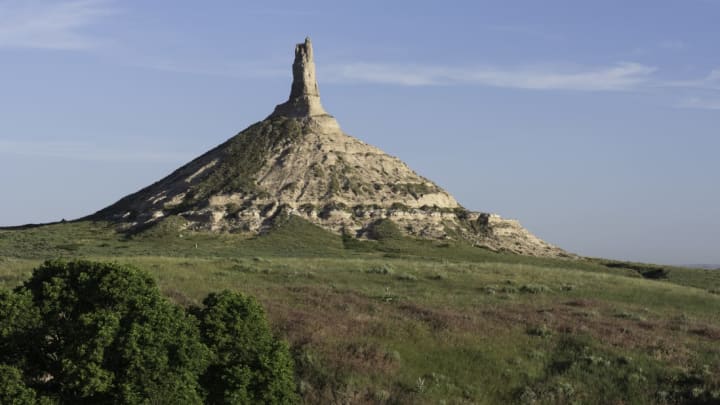Standing around 325 feet tall from peak to base, Chimney Rock looms like a lighthouse on the Great Plains. One of the most cherished landmarks in the Nebraska panhandle, it greeted thousands of emigrants who risked their lives to travel westward. Oh, and it also graced one of the most popular video games of all time. Load up your wagon with more facts about Chimney Rock.
1. Chimney Rock is a reminder of America’s volcanic past.
Chimney Rock is a hoodoo, a vertical pile of rock layers (or strata). The oldest of these layers is roughly 34 million years old, while the youngest was laid down 23 million years ago. Volcanic ash was a key component in many of the strata. About 37 million years ago, a series of volcanoes began to emerge in Nevada, Utah, and Colorado. Ashy clouds unleashed by their eruptions covered the Great Plains, blending with sands, silts, and clays. After several million years, the surface of the plains became elevated. Erosion then broke down the strata, revealing Chimney Rock's current shape. A hard sandstone cap at the summit could be shielding the softer, more vulnerable layers below from eroding as rapidly as they otherwise might.
2. One of Chimney Rock’s Native American names translates to “elk penis.”
That particular name, used by the Lakota Sioux, wasn’t popular with early white settlers or explorers, who instead called it “Elk Peak,” “Elk Brick,” “Nose Mountain,” and “The Chimney.” Although written descriptions of this formation date all the way back to 1830, the “Chimney Rock” moniker didn’t appear in print until 1842.
3. Travelers on the Oregon Trail used Chimney Rock as a marker.
Over 2000 miles in length, the historic Oregon Trail ran all the way from Missouri to the Pacific Northwest. It’s been estimated that as many as 500,000 travelers took this arduous route (and similar trails) during the 19th century. For many of them, seeing Chimney Rock was cause for celebration because it meant that the first (and easiest) third of their hard journey was just about over. Accordingly, when historian Merrill Mattes reviewed 300 journal entries written by pioneers on the Oregon Trail, she found more references to Chimney Rock than to any other landmark.
4. The California and Mormon Trails passed by Chimney Rock, too.
Popularized during the Gold Rush of the 1840s and 1850s, the California Trail covered much of the same ground as the better-known Oregon Trail. So did the Mormon Trail, a 1300-mile pathway that linked Nauvoo, Illinois, to Utah’s Great Salt Lake. Both routes came within sight of Chimney Rock.
5. Pioneers used to carve their names on Chimney Rock.
“I saw hundreds of names out in the rock, some at a dizzying height,” wrote one traveler in 1850. “I wrote mine above all except two and theirs were about 8 feet higher than mine.” Weathering and erosion have long since destroyed most of this graffiti, although a few monogram-covered rock samples have been removed from the site and preserved for posterity.
6. Chimney Rock was designated a National Historic Site on August 9, 1956.
To see it in person, and learn more about the rich history of this region, pop into the Ethel and Christopher J. Abbott Visitor’s Center in Bayard, Nebraska. There’s a viewing area where you can enjoy the rocky tower in all its glory, as well as an interactive museum complete with a miniature Chimney Rock ring-toss game.
7. Chimney Rock is featured on the Nebraska state quarter.
In 1999, the United States Mint kicked off the 50 States Quarters Program. Hoping to promote coin-collecting, the agency released a series of limited-edition commemorative quarters whose flipsides featured artistic tributes to each U.S. state. Nebraska’s quarter, released in 2006, shows a covered wagon driving past Chimney Rock. Hand-picked by then-governor Dave Heineman, the design was chosen over a renderings of the state capitol in Lincoln, the human figure atop the capitol, and Ponca chief Standing Bear [PDF].
8. When Chimney Rock debuted in the Oregon Trail video game series, it beat out two neighboring attractions.
Oregon Trail was conceived by Minnesota history teacher Don Rawitsch and his roommates in 1971. But the earliest editions didn’t include any of the geographical landmarks that actual settlers would have seen along the Oregon Trail. Enter Philip Bouchard, a designer who was tasked with upgrading the game for Apple II in 1984. To improve the aesthetics, he threw in some real-life natural wonders. “Chimney Rock was one of the most famous of all, and therefore an obligatory inclusion,” Bouchard told the Scottsbluff Star Herald in 2019. Wanting to space out the game’s landmarks, he omitted two equally impressive formations that greeted travelers on the Oregon Trail: Scotts Bluff and Courthouse Rock. Since they’re both located in western Nebraska, Bouchard felt they were “too close to Chimney Rock for me to include them in the game.”
9. Chimney Rock is still eroding today.
People have been questioning the rock’s stability for the better part of two centuries. “I am very sure it cannot stand many years before large flakes will slide to the ground if all does not come down in a general crash,” wrote emigrant Israel F. Hale in 1849. More than 150 years later, in the early 2000s, some critics said Chimney Rock didn’t belong on Nebraska’s state quarter because it’s eroding. The precise rate of erosion has never been determined—so it’s hard to know how much longer Chimney Rock will exist. But despite 15 decades of doubt about its future, this icon of the West still stands.
